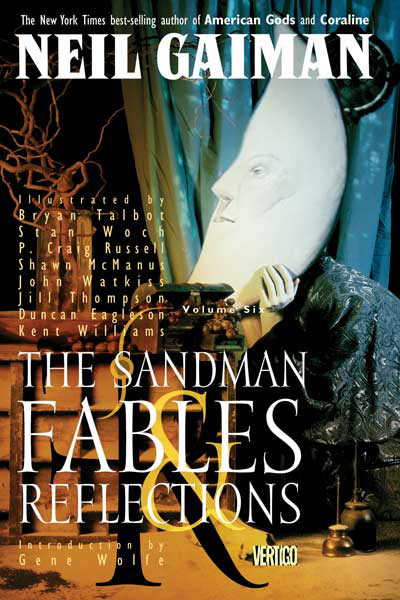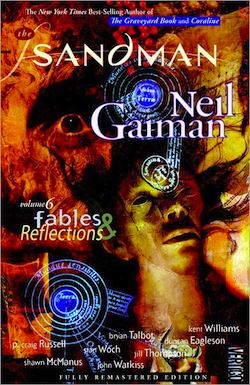Like the Dream Country collection, the sixth volume of Sandman trade paperbacks, titled Fables and Reflections, is an anthology of single-issue stories written by Neil Gaiman, set in the realms of Morpheus.
Fables and Reflections is a wider-ranging collection than Dream Country, compiling stories a bit out of sequence from their original release order. We get, for example, some stories in this volume originally released before A Game of You, some immediately after, and then others, like “Ramadan” from Sandman #50, that came out a year after the others. That makes it a more eclectic batch than we saw in Dream Country, and, I would argue, a less successful grouping. Some of the stories in this volume are very good, while I found others difficult to read through this time. Not all of them have aged well, and while Gaiman was surely fond of exploring different facets of his dream-time mythology, and pulling from histories and other books and stories to do so, he’s not great at making it all equally compelling. Such is the nature of anthology-style collections, even ones with a single author.
Of course, these stories don’t feature a single author anyway. With the multitude of artists involved, from Shawn McManus to Kent Williams to John Watkiss to Jill Thompson to P. Craig Russell, the stories range in visual style as much as they range in subject matter. A bit of the charm of this collection comes from seeing the way Gaiman shifts his approach (or how the effect of the stories becomes altered through the collaboration) depending on the artist’s style. These are all recognizably Gaimanesque tales, but each has its own distinctive feel. Gaiman and Talbot’s stunning Augustus Caesar story would surely have a completely different meaning if drawn by the more expressive but less sturdy Kent Williams, while the Gaiman and Williams opener would be less evocative without the boldly etched character work of Talbot providing a solid foundation. These are travels to Morpheus-tinged destinations, and much of the sightseeing pleasure derives from the artistic side of the voyage.
Honestly, this is not only one of the weakest collections in the whole original series of Sandman volumes, but much of it can be skipped if you’re looking to read Sandman from beginning to end. I never say that, by the way. I am a completist at heart, and I adore maximalism. Those chowder and cetology chapters in Moby-Dick? Read ‘em all, I say, even if they have nothing to do with Ishmael and Ahab and Melville’s bold declarations of philosophical import. But while I can’t bring myself to skip some of the lesser stories in Fables and Reflections, I don’t mind hinting to others that you could get away with jumping over the likes of “Three Septembers and a January” and “The Hunt” and even “Soft Places” and still get the essential Sandman experience. Those stories barely add anything to the larger Sandman story and so they rely entirely on their own charms. A bit lacking in those, I’m afraid, with the exception of John Watkiss’s classical brushwork in “Soft Places,” but his inking flair isn’t quite enough to power it through to make it worth a recommendation. Nice to look at, but not a great reading experience.
The stories that falter tend to be the ones where Gaiman seems to get hung up on detailing the life of a historical figure, or telling a folk tale for its own sake. That’s not always the case, for while the Marco Polo story in “Soft Places” isn’t of much interest, the Roman history in “Augustus” resonates with a fresh version of events that have been told many times before. Gaiman is able to provide something that feels like it matters when he tells of Augustus Caesar’s life, but his Marco Polo is as ephemeral as dreams themselves. So there’s no simple metric of where Gaiman goes wrong with some of these stories, but it’s easy to see where he gets things right: when he sticks with Morpheus and his family. Those are the single-issue stories that claw their way into the reader’s psychic space. Those are the ones that feel most viciously alive, while so many of the others seem like tepid drawing room lectures from a kind-hearted and clever visitor.
So the real meat of Fables and Reflections? It’s not “Ramadan,” the P. Craig Russell-illustrated story about the city in the bottle, even though that is an artistic highlight for the entire series. No, that story may look gorgeous, but it is too much of an example of Gaiman doing his impression of Arabian Nights and not enough of an original piece. Instead, it’s the two tales involving Orpheus, son of the dream king.
 Orpheus is, of course, no original character himself. But Gaiman isn’t trying to mimic Virgil or Ovid in his retelling. First, in “Thermidor,” he gives us a violent historical tale about Johanna Constantine amidst the French Revolution, with the head of Orpheus as a magical artifact capable of weird and terrible things. Then, in the one-shot special appropriately titled “Orpheus” (originally with a glow-in-the-dark cover in its original, floppy incarnation) Gaiman tells the whole tragic tale of the mythical musician and his fruitless descent into the underworld. It’s one of the best—and most important—stories in all of Sandman, which makes it even stranger that it wasn’t part of the original 75 issues of the series, but released as a stand-alone special instead. “Orpheus” has the whole of Sandman in its DNA. The missing brother, Destruction, appears prominently in the story, and Orpheus’s painful life, and non-death, is not just unusually brutal because it’s the story of Morpheus’s own son, but because, in retrospect, so much of this single issue parallels the larger story of Morpheus himself.
Orpheus is, of course, no original character himself. But Gaiman isn’t trying to mimic Virgil or Ovid in his retelling. First, in “Thermidor,” he gives us a violent historical tale about Johanna Constantine amidst the French Revolution, with the head of Orpheus as a magical artifact capable of weird and terrible things. Then, in the one-shot special appropriately titled “Orpheus” (originally with a glow-in-the-dark cover in its original, floppy incarnation) Gaiman tells the whole tragic tale of the mythical musician and his fruitless descent into the underworld. It’s one of the best—and most important—stories in all of Sandman, which makes it even stranger that it wasn’t part of the original 75 issues of the series, but released as a stand-alone special instead. “Orpheus” has the whole of Sandman in its DNA. The missing brother, Destruction, appears prominently in the story, and Orpheus’s painful life, and non-death, is not just unusually brutal because it’s the story of Morpheus’s own son, but because, in retrospect, so much of this single issue parallels the larger story of Morpheus himself.
It’s like Neil Gaiman was writing the structure of the Sandman series in miniature, complete with most of the same central themes, and compressing it into this one story about “Orpheus.” That makes it more than just the best story in this collection, it makes it the essential single installment out of the entire middle of the series. Of course, at the time of its release, I just saw it as one of many sideline stories tangentially dealing with Morpheus-related events. But it’s much bigger than that, ultimately.
So forget what I said earlier. Don’t skip around. Read this volume in its entirety, but don’t worry so much about all the other stories besides “Thermidor” and “Orpheus.” Those are the heart of the collection, and they’re the ones that will be most worth having in mind as you read or reread the rest of the series.
The decapitated head of Orpheus, in its relatively few appearances, matters a lot, it turns out. But even if it didn’t, it would still be worth reading about, because Gaiman makes it sing, literally and metaphorically.
NEXT TIME: A road trip gone wrong in Brief Lives.
Tim Callahan taught Greek mythology for years, which may explain why he’s partial to Gaiman’s Orpheus. But he also has the benefit of 20 years of hindsight on the general quality on display in this collection, which helps a lot.











While less essential, I tended to like the “collection” editions as a change of pace from the more unified story arc volumes. I would agree with you, Mr. Callahan, that “Thermidor” and “Orpheus” are the keystones to this volume, but the other tales all add something to the overall tale of Morpheus. “August” (lots of ‘months’ in this volume, no?), with the taut images of Augustus’s facial expressions, stays with me years after last re-reading it. And can we diss “The Parliament of Rooks” after it gifted us with chiba Dream and Death? I think not!
And, I must confess, I get awfully hungry for seafood soup when reading the “Chowder” chapter of Moby Dick.
this is where i started the series. someone on the old mightybigtv forums mentioned ‘lucifer morningstar’ and “a parliament of rooks,” so i had to check it out. the variety of art was kind of dazzling, particularly that arabian story. and i agree the “augustus” story was a shocker.
thanks for the re-read. your reviews are informative and well-considered.
Yeah, Three Septembers, Parliament, and August are all essential. The Hunt and Ramadan less so to the overarching story, perhaps, but excellent nonetheless. Soft Places is the only one that maybe could safely be skipped.
What collection contains the story of Emperor Norton?
I still think that Sandman reads better in the original order. This trade paperback includes stories from all over the original run: the ‘Distant Mirrors’, which are the ones that were named for months, which are, other than Ramandan supposed to go between ‘Season of Mists’ and ‘A Game of You’ (the Special with Orpheus’ story shows up shortly afer), the ‘Convergences’, which go between ‘A Game of You’ and ‘Brief Lives’, and Ramandan is supposed to go immediately after Brief Lives.
Moving the first appearances of Orpheus and Destruction so close to the beginning of Brief Lives completely distorts the entire story, and putting Ramadan before BL makes it lose all of its resonance.
I always liked Three septembers and a January because I’ve always loved the story of Emperor Norton ever since I first heard it years ago. And really all of these are great stories in their own way. Maybe not world shaking but nice vignette’s set in the Sandman universe.
@@.-@ – This collection contains the Emperor Norton story “Three Septembers and a January.”
Emperor Norton is the subject of “Three Septembers and a January” in this very collection.
I think “The Hunt” provides a subtle but essential character moment for Morpheus: Note his approval of Vassily’s choice not to do anything with the Duke’s daughter, besides returning her portrait. The one major sympathetic trait Murphy gets is maybe his valuing the unfulfilled dream; his respect for a mortal who understands the price of getting what you want. And it’s rarely enough shown that I think this instance is worth going through the 23 or so pages of background stuff to help put it together.